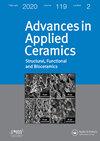通过渗铬提高碳钢和工具钢的力学性能
IF 1.6
4区 材料科学
Q3 MATERIALS SCIENCE, CERAMICS
引用次数: 1
摘要
摘要钢因其良好的力学性能而被广泛用于高性能苛刻的应用中。各种表面工程技术已经被开发出来,其中铬化是一种经济实惠的高通量表面硬化工艺,可以在保持基体延展性和韧性的同时提高表面硬度和耐磨性。在这项工作中,摩擦学测试以及纳米和微压痕、形态和成分表征被用来了解铬化工艺对AISI 1095碳钢、52100轴承钢和A2、D2和M2工具钢的影响。本研究结果表明,低成本的1095和52100钢的铬化处理显著提高了它们的耐磨性能和硬度,达到了与更昂贵的工具钢相当的水平。铬化处理提高了工具钢的硬度,但对D2和M2工具钢的耐磨性没有明显改善。作者要感谢橡树岭国家实验室(ORNL)的Jim Keiser,阿贡国家实验室的Oyelayo O. Ajayi和George Fenske,感谢他们深思的评论和见解,感谢应用热涂层公司的Briar Faulkner对钢样品进行铬化处理,感谢ORNL的Brain Long和Caitlin Duggan对样品进行切片和抛光,用于形态学和纳米压痕研究。这项研究由美国能源部能源效率和可再生能源办公室生物能源技术办公室的原料转换接口联盟(FCIC)赞助。披露声明作者未报告潜在的利益冲突。作者说明:本手稿由UT-Battelle, LLC根据合同编号:DE-AC05-00OR22725与美国能源部。美国政府保留和出版商,通过接受文章的出版,承认美国政府保留非排他性的,付费的,不可撤销的,世界范围的许可,为美国政府的目的出版,或复制该手稿的出版形式,或允许其他人这样做。能源部将根据能源部公共访问计划(http://energy.gov/downloads/doe-public-access-plan).Additional)向公众提供这些由联邦政府资助的研究成果。这项工作由能源效率和可再生能源办公室支持:[授权号]。本文章由计算机程序翻译,如有差异,请以英文原文为准。
Improving mechanical properties of carbon and tool steels via chromizing
ABSTRACTSteels are commonly used in high-performance demanding applications due to their favourable mechanical properties. Various surface engineering techniques have been developed for steels, among which chromizing is an affordable high-throughput case-hardenig process for improved surface hardness and wear resistance while retaining the substrate ductility and toughness. In this work, tribological testing along with nano- and micro-indentation and morphological and composional characterisation were used to understand the effects of the chromizing process on the AISI 1095 carbon steel, 52100 bearing steel and A2, D2 and M2 tool steels. The results of this study demonstrate that the chromizing treatment of low-cost 1095 and 52100 steels significantly improves their wear and hardness properties to a level comparable to the more costly tool steels. While chromizing also increased the hardness of the tool steels, it had little improvement on the wear resistance for the D2 and M2 tool steels.KEYWORDS: Case chromizingsteelabrasive wearnanoindentation AcknowledgementsThe authors would like to thank Jim Keiser from Oak Ridge National Laboratory (ORNL), Oyelayo O. Ajayi and George Fenske from Argonne National Laboratory for their thoughtful comments and insight, Briar Faulkner from Applied Thermal Coatings for conducting chromizing of the steel samples, and Brain Long and Caitlin Duggan from ORNL for sectioning and polishing the samples for morphological and nanoindentation studies. This research was sponsored by the Feedstock Conversion Interface Consortium (FCIC) of the Bioenergy Technologies Office, Office of Energy Efficiency and Renewable Energy, United States Department of Energy (DOE).Disclosure statementNo potential conflict of interest was reported by the authors.Author NoteThis manuscript has been authored by UT-Battelle, LLC under Contract No. DE-AC05-00OR22725 with the U.S. Department of Energy. The United States Government retains and the publisher, by accepting the article for publication, acknowledges that the United States Government retains a non-exclusive, paid up, irrevocable, world-wide license to publish, or reproduce the published form of this manuscript, or allow others to do so, for United States Government purposes. The Department of Energy will provide public access to these results of federally sponsored research in accordance with the DOE Public Access Plan (http://energy.gov/downloads/doe-public-access-plan).Additional informationFundingThis work was supported by Office of Energy Efficiency and Renewable Energy: [Grant Number].
求助全文
通过发布文献求助,成功后即可免费获取论文全文。
去求助
来源期刊

Advances in Applied Ceramics
工程技术-材料科学:硅酸盐
CiteScore
4.40
自引率
4.50%
发文量
17
审稿时长
5.2 months
期刊介绍:
Advances in Applied Ceramics: Structural, Functional and Bioceramics provides international coverage of high-quality research on functional ceramics, engineering ceramics and bioceramics.
 求助内容:
求助内容: 应助结果提醒方式:
应助结果提醒方式:


